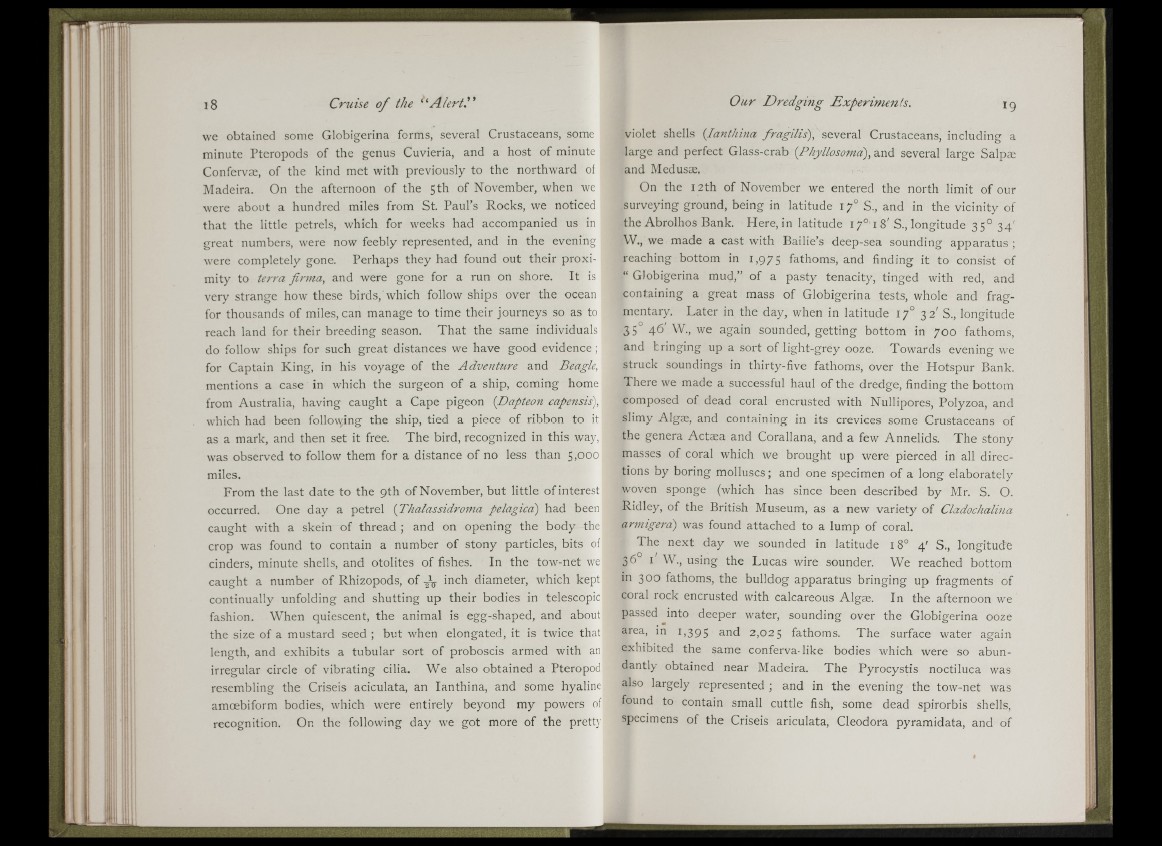
Its]
'.i
Ih'-ia
1 I
i8 Cruise o f the “ A/ertP
we obtained some Globigerina forms, several Crustaceans, some
minute Pteropods of the genus Cuvieria, and a host of minute
Confervae, of the kind met with previously to the northward oi
Madeira. On the afternoon of the 5th of November, when we
were about a hundred miles from St. Paul’s Rocks, we noticed
that the little petrels, which for weeks had accompanied us in
great numbers, were now feebly represented, and in the evening
were completely gone. Perhaps they had found out their proximity
to terra firma, and were gone for a run on shore. It is
very strange how these birds, which follow ships over the ocean
for thousands of miles, can manage to time their journeys so as to
reach land for their breeding season. That the same individuals
do follow ships for such great distances we have good evidence ;
for Captain King, in his voyage of the Adventure and Beagle,
mentions a case in which the surgeon of a ship, coming home
from Australia, having caught a Cape pigeon {Dapteon capensis),
which had been following the ship, tied a piece of ribbon to it
as a mark, and then set it free. The bird, recognized in this way,
was observed to follow them for a distance of no less than 5,000
miles.
From the last date to the 9th of November, but little of interest
occurred. One day a petrel [Thalassidroma pelagica) had been
caught with a skein of thread ; and on opening the body the
crop was found to contain a number of stony particles, bits of
cinders, minute shells, and otolites of fishes. In the tow-net we
caught a number of Rhizopods, of inch diameter, which kept
continually unfolding and shutting up their bodies in telescopic
fashion. When quiescent, the animal is egg-shaped, and about
the size of a mustard seed ; but when elongated, it is twice that
length, and exhibits a tubular sort of proboscis armed with an
irregular circle of vibrating cilia. We also obtained a Pteropod
resembling the Criseis aciculata, an lanthina, and some hyaline
amoebiform bodies, which were entirely beyond my powers of
recognition. On the following day we got more of the pretty
Our Dredging Experiments. 19
violet shells [lanthina fragilis), several Crustaceans, including a
large and perfect Glass-crab [Phyllosoma), and several large Salpm
and Medusae.
On the 12th of November we entered the north limit of our
surveying ground, being in latitude 17° S., and in the vicinity of
the Abrolhos Bank. Here, in latitude 1 7° 18' S., longitude 3 5° 34'
W., we made a cast with Bailie’s deep-sea sounding apparatus ;
reaching bottom in 1,975 fathoms, and finding it to consist of
“ Globigerina mud,” of a pasty tenacity, tinged with red, and
containing a great mass of Globigerina tests, whole and fragmentary.
Later in the day, when in latitude 17° 32' S., longitude
35° 46' W., we again sounded, getting bottom in 700 fathoms,
and bringing up a sort of light-grey ooze. Towards evening we
struck soundings in thirty-five fathoms, over the Hotspur Bank.
There we made a successful haul of the dredge, finding the bottom
composed of dead coral encrusted with Nullipores, Polyzoa, and
slimy Algce, and containing in its crevices some Crustaceans of
the genera Actaea and Corallana, and a few Annelids. The stony
masses of coral which we brought up were pierced in all directions
by boring molluscs; and one specimen of a long elaborately
woven sponge (which has since been described by Mr. S. O.
Ridley, of the British Museum, as a new variety of Cladochalina
arniigera) was found attached to a lump of coral.
The next day we sounded in latitude 18° 4' S., longitude
36 I W., using the Lucas wire sounder. We reached bottom
in 300 fathoms, the bulldog apparatus bringing up fragments of
coral rock encrusted with calcareous Algae. In the afternoon we
passed into deeper water, sounding over the Globigerina ooze
area, in 1,395 2,025 fathoms. The surface water again
exhibited the same conferva-like bodies which were so abundantly
obtained near Madeira. The Pyrocystis noctiluca was
also largely represented ; and in the evening the tow-net was
found to contain small cuttle fish, some dead spirorbis shells,
specimens of the Criseis ariculata, Cleodora pyramidata, and of
r